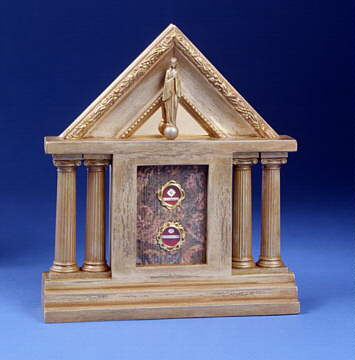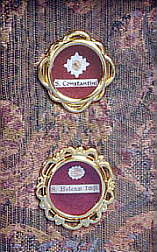 Other Languages
Other Languages
Relics of Constantine, and his mother, St. Helen.
 St. Helena was the daughter of an innkeeper in England, and despite her lowly station, was married to Constantius Chlorus, a Roman general. They had one son, Constantine. After 22 years of marriage, her husband was named Caesar under Emperor Maximian, and immediately divorced Helena to marry Maximian's stepdaughter for political gain. Fourteen years later, Constantius died, his son was proclaimed Caesar, and 18 months later, Emperor. Constantine made up for the neglecte his father paid to St. Helena, ordering all honor be paid to the mother of the sovereign. She converted to Christianity about the same time, when she was 63 years old, in the years 312-313.
St. Helena was the daughter of an innkeeper in England, and despite her lowly station, was married to Constantius Chlorus, a Roman general. They had one son, Constantine. After 22 years of marriage, her husband was named Caesar under Emperor Maximian, and immediately divorced Helena to marry Maximian's stepdaughter for political gain. Fourteen years later, Constantius died, his son was proclaimed Caesar, and 18 months later, Emperor. Constantine made up for the neglecte his father paid to St. Helena, ordering all honor be paid to the mother of the sovereign. She converted to Christianity about the same time, when she was 63 years old, in the years 312-313.
 It was her son who issued the now famous "Edict of Milan", permitting Christianity in the Empire.
It was her son who issued the now famous "Edict of Milan", permitting Christianity in the Empire.
Constantine sent his mother Helena to Jerusalem to try to find the cross on which our Lord was crucified. When she arrived, she bade all the Jewish Rabbis of the whole land gather to meet her. Great was their fear. They suspected that she sought the wood of the cross, a secret which they had promised not to reveal even under torture, because it would mean the end of Jewish supremacy. When they met her, sure enough, she asked for the place of the crucifixion. When they would not tell, she ordered them all to be burned. Frightened, they delivered up a man named Judas (not Iscariot), saying that he would tell. She gave him his choice of telling or dying by starvation. At first he was obstinate, but six days of total abstinence from food brought him to terms, and on the seventh he promised. He was conducted to the place indicated, and in response to prayer there was a sort of earthquake, and a perfume filled the air which converted Judas. There was a temple of Venus on the spot, which the queen had destroyed. Judas set to digging vigorously, and at the depth of twenty feet, found three crosses, which he brought to Helena.

The Vision of St. Helen
|
The true cross was tested by its' causing a man to rise from the dead, or according to others, by healing a woman, or according to others, by finding the inscription of Pilate. After an exceedingly vigorous conversation between the devil and Judas, the latter was baptized and became Bishop Cyriacus. Then Helena set him hunting for the nails of the cross. He found them shining like gold and brought them to the queen, who departed, taking them and a portion of the wood of the cross. She brought the nails to Constantine, who put them on his bridle and helmet, or according to another account, two were used in this way, and one was thrown into the Adriatic Sea.
St. Helen went to Palestine where she found the True Cross. She built Churches in Bethlehem, Egypt, the Mount of Olives, and Mount Calvary, and died in Palestine during these activities. She
|
was buried in a mausoleum attached to the basilicas of Sts. Marcellinus & Peter. Her remains are now located in the Vatican Museum. Although St. Constantine does not appear on the Roman calendar, he is recognized as a saint by the Catholic Church.
 Saints Alive! home page
Saints Alive! home page
The True Cross of Ghent Another Relic of the True Cross

© 1997-1998, Saints Alive!
Last edited March 21, 1998
 St. Helena was the daughter of an innkeeper in England, and despite her lowly station, was married to Constantius Chlorus, a Roman general. They had one son, Constantine. After 22 years of marriage, her husband was named Caesar under Emperor Maximian, and immediately divorced Helena to marry Maximian's stepdaughter for political gain. Fourteen years later, Constantius died, his son was proclaimed Caesar, and 18 months later, Emperor. Constantine made up for the neglecte his father paid to St. Helena, ordering all honor be paid to the mother of the sovereign. She converted to Christianity about the same time, when she was 63 years old, in the years 312-313.
St. Helena was the daughter of an innkeeper in England, and despite her lowly station, was married to Constantius Chlorus, a Roman general. They had one son, Constantine. After 22 years of marriage, her husband was named Caesar under Emperor Maximian, and immediately divorced Helena to marry Maximian's stepdaughter for political gain. Fourteen years later, Constantius died, his son was proclaimed Caesar, and 18 months later, Emperor. Constantine made up for the neglecte his father paid to St. Helena, ordering all honor be paid to the mother of the sovereign. She converted to Christianity about the same time, when she was 63 years old, in the years 312-313. It was her son who issued the now famous "Edict of Milan", permitting Christianity in the Empire.
It was her son who issued the now famous "Edict of Milan", permitting Christianity in the Empire.